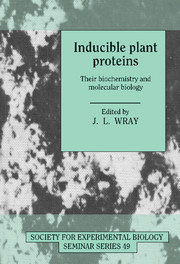Book contents
- Frontmatter
- Contents
- List of Contributors
- Preface
- Metal-binding proteins and metal-regulated gene expression in higher plants
- Phosphate starvation inducible enzymes and proteins in higher plants
- Nitrate reduction in higher plants: molecular approaches to function and regulation
- Inducibility of the glutamine synthetase gene family in Phaseolus vulgaris L.
- Expression and manipulation of genes involved in phenylpropanoid biosynthesis
- Biochemistry and molecular biology of CAM
- ABA- and GA-responsive gene expression
- Regulation of gene expression, ethylene synthesis and ripening in transgenic tomatoes
- Induction of nodulin genes and root nodule symbiosis
- Systemic acquired resistance: an inducible defence mechanism in plants
- Biochemistry and molecular biology of the anaerobic response
- The heat shock response in transgenic plants: the use of chimaeric heat shock genes
- Biochemistry and molecular biology of cold-inducible enzymes and proteins in higher plants
- GBF-1, GBF-2 and GBF-3: three Arabidopsis b-Zip proteins that interact with the light-regulated rbcS-1A promoter
- Index
The heat shock response in transgenic plants: the use of chimaeric heat shock genes
Published online by Cambridge University Press: 06 July 2010
- Frontmatter
- Contents
- List of Contributors
- Preface
- Metal-binding proteins and metal-regulated gene expression in higher plants
- Phosphate starvation inducible enzymes and proteins in higher plants
- Nitrate reduction in higher plants: molecular approaches to function and regulation
- Inducibility of the glutamine synthetase gene family in Phaseolus vulgaris L.
- Expression and manipulation of genes involved in phenylpropanoid biosynthesis
- Biochemistry and molecular biology of CAM
- ABA- and GA-responsive gene expression
- Regulation of gene expression, ethylene synthesis and ripening in transgenic tomatoes
- Induction of nodulin genes and root nodule symbiosis
- Systemic acquired resistance: an inducible defence mechanism in plants
- Biochemistry and molecular biology of the anaerobic response
- The heat shock response in transgenic plants: the use of chimaeric heat shock genes
- Biochemistry and molecular biology of cold-inducible enzymes and proteins in higher plants
- GBF-1, GBF-2 and GBF-3: three Arabidopsis b-Zip proteins that interact with the light-regulated rbcS-1A promoter
- Index
Summary
Introduction
The heat shock (hs) response in living cells is a fascinating subject for studying molecular mechanisms of stress-dependent regulation of gene expression and its phenotypic consequences (for reviews see Schöffl, 1988; Neumann et al., 1989; Morimoto et al., 1990; Nover, 1990). Particularly important is the transient acquisition of increased thermotolerance following a sublethal heat stress. Although exceptions occur, a positive correlation exists between the amount of hs proteins (hsps) synthesised in response to hyperthermia and the degree of tolerance. The synthesis of hsps seems to be necessary but may not be sufficient for thermotolerance. In different organisms different hsps are important for thermotolerance; the inability to synthesise hsps is usually correlated with thermosensitivity and an inability to acquire thermotolerance.
An example of a naturally occurring inability to synthesise hsp60, the sole hsp of the genus Hydra, is found in the thermosensitive species H. oligactis which is restricted to an ecological niche where it rarely encounters increasing water temperatures (Bosch et al., 1988). Mutations negatively affecting the hs response and thermotolerance properties have been described for Dictyostelium, Tetrahymena, Escherichia coli and yeast (for reviews see Neidhardt et al., 1984; Lindquist, 1986; Lindquist & Craig, 1988). A contrasting phenotype is exhibited by double mutations in two ubiquitin-conjugating enzymes of yeast which lead to the constitutive expression of hsps (Jentsch et al., 1990).
- Type
- Chapter
- Information
- Inducible Plant ProteinsTheir Biochemistry and Molecular Biology, pp. 247 - 266Publisher: Cambridge University PressPrint publication year: 1992
- 3
- Cited by



